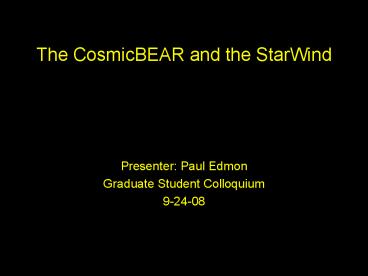The CosmicBEAR and the StarWind - PowerPoint PPT Presentation
1 / 20
Title:
The CosmicBEAR and the StarWind
Description:
General Topic: Numerical Modeling of Particle ... Credit: Jacob's Rocketry. Solar Wind. O Stars and WR Stars. O Star. Main Sequence. Mass: 20-100 M?? ... – PowerPoint PPT presentation
Number of Views:41
Avg rating:3.0/5.0
Title: The CosmicBEAR and the StarWind
1
The CosmicBEAR and the StarWind
- Presenter Paul Edmon
- Graduate Student Colloquium
- 9-24-08
2
The CosmicBEAR and the StarWind
3
Outline
- Brief Introduction
- Current Research
- Stellar Winds and Particle Acceleration
- CosmicBEAR
4
Introduction
- Hometown Seattle, WA
- 5th Year Graduate Student
- Adviser Tom Jones
- Currently ABD
- Office Walter 415
5
Current Research
- General Topic Numerical Modeling of Particle
Acceleration and Radiative Processes in
Astrophysical Shocks - Projects
- CosmicBEAR Code for Ph.D. Project
- Particle Acceleration in Stellar Winds from High
Mass Stars Ph.D. Project - Evolution of Stellar Winds from Low Mass Stars
- Nonthermal Radiation from Type Ia Supernovae
Continuation of 2nd Year Project - Gamma Rays from IC off of Pairs produced from
UHECR interaction with EBL - AstroBEAR Code Development
6
Stellar Winds
- Outflows from Stars
- De Laval Nozzle
- Drivers
- Gas Pressure Sun
- Radiative Pressure
- Dust RGB Stars
- Lines O, WR Stars
- Alfvén Waves?
Credit Jacobs Rocketry
7
Solar Wind
8
O Stars and WR Stars
- O Star
- Main Sequence
- Mass 20-100 M?
- Temperature 40,000 K
- Luminosity 500,000 L?
- Lifetime 3 Myr
- Mass Loss Rate 10-6 M?/yr
- Wind Velocity 3000-4000 km/s
- Wolf-Rayet Star
- Evolved O Stars (WC, WN)
- Mass 20-50 M?
- Temperature 25,000-50,000K
- Luminosity 1,000,000 L?
- Lifetime 100 kyr
- Mass Loss Rate 10-5 M?/yr
- Wind Velocity 2000 km/s
9
Nonthermal Radio, X-ray and TeV Emission
- Radio
- Emission Seen from about a quarter of O and WR
Stars - Synchrotron Emission
- X-Ray
- Thought to be Emission from WR Stars in Certain
Cases - Inverse Compton
- TeV Gamma-Rays
- TeV Emission Seen in Young Star Clusters and
Single WR Stars - IC or Pion Decay
Credit HESS page on Westerlund 2
10
Diffusive Shock Acceleration (DSA)
- Model
- A thermal population of protons enter the shock
- Protons from the high energy tail diffuse through
the shock scattering off of Alfvén waves - Maximum possible accelerated energy is limited by
the physical extent of the system and gyroradius
of the proton
u1
u2
11
Shocks
- What type of shock is producing the particle
population? - Internal Shocks Instabilities in the Wind
- Termination Shock Interaction with Interstellar
Medium (ISM) - Colliding Wind Shock Binary Interaction
12
Current State of the Art
- Dougherty Williams (2000) Non-thermal emitting
WR Stars are Binaries with Colliding Winds - Van Loo et.al. (2005, 2006)
- 1-D Hydro with no electron reacceleration
- Emission can be explained by
- Single Strong Shock
- Multiple Strong Shocks
- For Multiple Strong Shocks the shock strength
falls off with radius which leads to the wrong
spectral index, plus a lot of shocks are needed - Van Loo favors colliding wind scenario similar to
WR stars
13
Requests from the Community
- Pittard Dougherty (2006)
- Actual DSA modeling for these systems
- How much preshock energy goes into the particles
- Model should include losses
- Outstanding Questions
- Is the efficiency of particle acceleration high
enough for shock modification to occur? - Are particles reaccelerated in wind embedded
shocks? - What effect does anisotropic winds have on
colliding winds?
14
Plan
- Develop 2-D Magnetohydrodynamic (MHD) Code that
includes DSA with losses - Model DSA and Emissions from a single O and WR
Star - Do the same for a Colliding Wind Scenario
15
Execution
- 2-D MHD Solver AstroBEAR
- DSA Solver CGMV
- AstroBEARCGMV ? CosmicBEAR
- Emissions Cosmicp
16
AstroBEAR
- Astronomical Boundary Embedded Adaptive
Refinement - MUSCL Solver
- Adaptive Mesh Refinement
- Uses Constrained Transport for MHD
- Developed by Sorin Mitran (UNC) and Adam Franks
Group (University of Rochester) with some help
from Tom
Credit Lawrence Berkeley National Lab
17
AstroBEAR Solar Wind
18
CGMV
- CGMV Coarse Grained finite Momentum Volume
(Jones Kang 2005) - Solves the Diffusion-Convection equation with an
order of magnitude less bins - Takes advantage of the fact that the particle
spectrum is going to be a power-law - Works with the first two moments of the
Diffusion-Convection equation - Scheme
- Crank-Nicholson
- Implicit Unconditionally Stable
- May not work well with AMR
- Explicit
- Conditionally Stable Time step constrained by
shortest diffusion time. - Works with AMR
19
CosmicBEAR
- Goals
- Successfully Merge AstroBEAR and CGMV
- Make CR step execution time close to or equal to
the MHD step execution time - Add in corrections for Cylindrical Geometry
- Verify Code
- Start doing Science!
- Current Status
- Code successfully merged but new CR solver needs
to be implemented
20
Summary
- Stellar Winds
- Single Wind vs. Colliding Wind
- Shock Modification?
- 1-D vs. 2-D
- CosmicBEAR
- Parallel 2-D MHD-DSA AMR code































